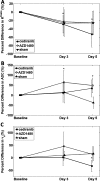Comparisons of the efficacy of a Jak1/2 inhibitor (AZD1480) with a VEGF signaling inhibitor (cediranib) and sham treatments in mouse tumors using DCE-MRI, DW-MRI, and histology
- PMID: 22355274
- PMCID: PMC3281942
- DOI: 10.1593/neo.111478
Comparisons of the efficacy of a Jak1/2 inhibitor (AZD1480) with a VEGF signaling inhibitor (cediranib) and sham treatments in mouse tumors using DCE-MRI, DW-MRI, and histology
Abstract
Jak1/2 inhibition suppresses STAT3 phosphorylation that is characteristic of many cancers. Activated STAT3 promotes the transcription of factors that enhance tumor growth, survival, and angiogenesis. AZD1480 is a novel small molecule inhibitor of Jak1/2, which is a key mediator of STAT3 activation. This study examined the use of diffusion-weighted (DW) and dynamic contrast-enhanced (DCE) magnetic resonance imaging (MRI) biomarkers in assessing early tumor response to AZD1480. Cediranib (AZD2171), a vascular endothelial growth factor signaling inhibitor, was used as a comparator. Thirty mice were injected with Calu-6 lung cancer cells and randomized into the three treatment groups: AZD1480, cediranib, and sham. DW-MRI and DCE-MRI protocols were performed at baseline and at days 3 and 5 after treatment. The percent change from baseline measurements for K(trans), ADC, and v(e) were calculated and compared with hematoxylin and eosin (H&E), CD31, cParp, and Ki-67 histology data. Decreases in K(trans) of 29% (P < .05) and 53% (P < .05) were observed at days 3 and 5, respectively, for the cediranib group. No significant changes in K(trans) occurred for the AZD1480 group, but a significant increase in ADC was demonstrated at days 3 (63%, P < .05) and 5 (49%, P < .05). CD31 staining indicated diminished vasculature in the cediranib group, whereas significantly increased cParp staining for apoptotic activity and extracellular space by image analysis of H&E were present in the AZD1480 group. These imaging biomarker changes, and corresponding histopathology, support the use of ADC, but not K(trans), as a pharmacodynamic biomarker of response to AZD1480 at these time points.
Figures









Similar articles
-
Effect of AZD1480 in an epidermal growth factor receptor-driven lung cancer model.Lung Cancer. 2014 Jan;83(1):30-6. doi: 10.1016/j.lungcan.2013.10.011. Epub 2013 Oct 29. Lung Cancer. 2014. PMID: 24238495
-
Inhibition of STAT3 with orally active JAK inhibitor, AZD1480, decreases tumor growth in Neuroblastoma and Pediatric Sarcomas In vitro and In vivo.Oncotarget. 2013 Mar;4(3):433-45. doi: 10.18632/oncotarget.930. Oncotarget. 2013. PMID: 23531921 Free PMC article.
-
The Janus kinases inhibitor AZD1480 attenuates growth of small cell lung cancers in vitro and in vivo.Clin Cancer Res. 2013 Dec 15;19(24):6777-86. doi: 10.1158/1078-0432.CCR-13-1110. Epub 2013 Oct 24. Clin Cancer Res. 2013. PMID: 24158701 Free PMC article.
-
Pharmacologic suppression of JAK1/2 by JAK1/2 inhibitor AZD1480 potently inhibits IL-6-induced experimental prostate cancer metastases formation.Mol Cancer Ther. 2014 May;13(5):1246-58. doi: 10.1158/1535-7163.MCT-13-0605. Epub 2014 Feb 27. Mol Cancer Ther. 2014. PMID: 24577942 Free PMC article.
-
DCE-MRI biomarkers in the clinical evaluation of antiangiogenic and vascular disrupting agents.Br J Cancer. 2007 Jan 29;96(2):189-95. doi: 10.1038/sj.bjc.6603515. Epub 2007 Jan 9. Br J Cancer. 2007. PMID: 17211479 Free PMC article. Review.
Cited by
-
Characterizing Trastuzumab-Induced Alterations in Intratumoral Heterogeneity with Quantitative Imaging and Immunohistochemistry in HER2+ Breast Cancer.Neoplasia. 2019 Jan;21(1):17-29. doi: 10.1016/j.neo.2018.10.008. Epub 2018 Nov 23. Neoplasia. 2019. PMID: 30472501 Free PMC article.
-
Magnetic resonance imaging identifies early effects of sunitinib treatment in human melanoma xenografts.J Exp Clin Cancer Res. 2013 Nov 19;32(1):93. doi: 10.1186/1756-9966-32-93. J Exp Clin Cancer Res. 2013. PMID: 24245934 Free PMC article.
-
Early detection of antiangiogenic treatment responses in a mouse xenograft tumor model using quantitative perfusion MRI.Cancer Med. 2014 Feb;3(1):47-60. doi: 10.1002/cam4.177. Epub 2014 Jan 6. Cancer Med. 2014. PMID: 24403176 Free PMC article.
-
Early detection of Lewis lung carcinoma tumor control by irradiation using diffusion-weighted and dynamic contrast-enhanced MRI.PLoS One. 2013 May 2;8(5):e62762. doi: 10.1371/journal.pone.0062762. Print 2013. PLoS One. 2013. PMID: 23658769 Free PMC article.
-
Targeting SH2 domains in breast cancer.Future Med Chem. 2014;6(17):1909-26. doi: 10.4155/fmc.14.120. Future Med Chem. 2014. PMID: 25495984 Free PMC article. Review.
References
-
- Dy GK, Adjei AA. Systemic cancer therapy: evolution over the last 60 years. Cancer. 2008;113:1857–1887. - PubMed
-
- Yu H, Jove R. The STATs of cancer—new molecular targets come of age. Nat Rev Cancer. 2004;4:97–105. - PubMed
-
- Bowman T, Garcia R, Turkson J, Jove R. STATs in oncogenesis. Oncogene. 2000;19:2474–2488. - PubMed
-
- Niu G, Bowman T, Huang M, Shivers S, Reintgen D, Daud A, Chang A, Kraker A, Jove R, Yu H. Roles of activated Src and Stat3 signaling in melanoma tumor cell growth. Oncogene. 2002;21:7001–7010. - PubMed
Publication types
MeSH terms
Substances
Grants and funding
LinkOut - more resources
Full Text Sources
Medical
Research Materials
Miscellaneous
